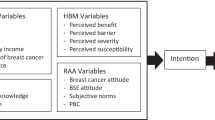Abstract
The present study examined compliance with the three recommended breast self-examination (BSE) positions over a 6-month follow-up period. An ongoing behavioral measure that provided information about the type of exam performed during each BSE occasion was employed. Results indicated that adherence to all three position types was obtained in only 40% of the exams. Forty-two percent of exams were comprised of only one position, with the supine position being the most frequently practiced exam type. Implications of these results with regard to BSE research and current breast cancer screening recommendations are discussed.
Similar content being viewed by others
References
American Cancer Society (1988).A Special Touch (videotape).
Assaf, A. R., Cummings, K. M., Graham, S., Mettlin, C., and Marshall, J. R. (1985). Comparison of three methods of teaching women how to perform breast self-examination.Health Educ. Q. 12: 259–272.
Baines, C. (1992). Breast self-examination.Cancer 69 (Suppl.): 1942–1946.
Beach, D. L., and Mayer, J. A. (1990). The effects of social demand on breast self-examination self-report.J. Behav. Med. 13: 195–204.
Bennett, S. E., Lawrence, R. S., Angiolillo, D. F., Bennett, S. D., Budman, S., Schneider, G. M., Assaf, A. R., and Feldstein, M. (1990). Effectiveness of methods used to teach breast self-examination.Am. J. Prev. Med. 6: 208–217.
Celentano, D. D., and Holtzman, D. (1983). Breast self-examination competency: An analysis of self-reported practice and associated characteristics.Am. J. Public Health 73: 1321–1323.
Fletcher, S. W., O'Malley, M. S., Earp, J. L., Morgan, T. M., Lin, S., and Degnan, D. (1990). How to best teach women breast self-examination: A randomized controlled trial.Ann. Intern. Med. 112: 772–779.
Gallup Organization, Inc. (1988).1987 Survey of Public Awareness Use of Cancer Detection Test: Summary of Findings, Gallup Organization, Inc., Princeton, NJ.
Grady, K. E. (1984). Cue enhancement and the long-term practice of breast self-examination.J. Behav. Med. 7: 191–204.
Grady, K. E., Goodenow, C., and Borkin, J. R. (1988). Effect of reward on compliance with breast self-examination.J. Behav. Med. 11: 43–57.
Haagensen, C. D. (1986). Women's role in recognizing the symptoms of breast disease.Diseases of the Breast, W. B. Saunders, Pennsylvania, pp. 501–515.
Hailey, B. J., Lalor, K. M., Byrne, H., Starling, L., and Eppling, F. (April, 1990). The effect of reward on breast self-examination among college women. Paper presented at the 11th Annual Meeting of the Society of Behavioral Medicine, Chicago, IL.
Hill, D., White, V., Jolley, D., and Mapperson, K. (1988). Self-examination of the breast: Is it beneficial? Meta-analysis of studies investigating breast self-examination and extent of disease in patients with breast cancer.Br. Med. J. 297: 271–275.
Howe, H. L. (1980). Proficiency in performing breast self-examination.Patient Counsel. Health Educ. 2: 151–153.
Huguley, C. M., and Brown, R. L. (1981). The value of breast self-examination.Cancer 47: 989–995.
Kenney, E. M., Dockter, B., Chin, L., Howell, M. F., and Black, D. R. (1984). Behavioral rehearsal training for breast self-examination: A quasi-experimental analysis. Paper presented at the fifth annual meeting of the Society of Behavioral Medicine.
Laughter, D. C., Kean, T. J., Drean, K. D., Esparza, D., Hortobagyi, G., Judkins, A., Levitt, D. Z., Marcus, C., and Silberberg, Y. (1981). The breast self-examination practices of high risk women: Implications for patient education.Patient Counsel. Health Educ. third quarter: 103–107.
Lavine, B. J., and Hailey, B. J. (1991). Comparing methods of reporting breast self-examination compliance.Health Care Women Int. 12: 63–71.
Mayer, J. A. (1986). Assessing breast self-examination compliance in the natural environment.J. Behav. Med. 9: 363–371.
Mayer, J. A., Beach, D. L., Carter, M., Hillman, E., and Kellogg, M. C. (1991). The effects of co-worker delivered prompts on breast self-examination frequency.Am. J. Prev. Med. 7: 9–11.
Mayer, J. A., Dubbert, P. A., Scott, R. R., Dawson, B. L., Ekstrand, M. L., and Fondren, T. G. (1987). Breast self-examination: The effect of personalized prompts on practice frequency.Behav. Ther. 2: 135–146.
McKenna, R. J., Greene, P., Winchester, D. P., Baines, C. J., Foster, R. S., Champion, V. and O'Malley, M. (1992). Workshop III: Breast self-examination and breast physical examination.Cancer 69 (Suppl.): 2003–2004.
Newcomb, P. A., Weiss, N. S., Storer, B. E., Scholes, D., Young, B. E., and Voigt, L. F. (1991). Breast self-examination in relation to occurrence of advanced breast cancer.J. Nat. Cancer Inst. 83: 260–265.
Stevens, V. M., Hatcher, J. W., Bruce, B. K., and Ivnik, M. (1991). Effects of extended behavioral rehearsal and corrective feedback on breast self-examination. Paper presented at the Twelfth Annual Scientific Sessions of the Society of Behavioral Medicine, Washington, DC.
Winchester, D. P. (1992). Physical examination of the breast.Cancer 69 (Suppl.): 1947–1949.
Author information
Authors and Affiliations
Rights and permissions
About this article
Cite this article
Stevens, V.M., Hatcher, J.W. & Bruce, B.K. How compliant is compliant? Evaluating adherence with breast self-exam positions. J Behav Med 17, 523–534 (1994). https://doi.org/10.1007/BF01857924
Accepted:
Issue Date:
DOI: https://doi.org/10.1007/BF01857924




